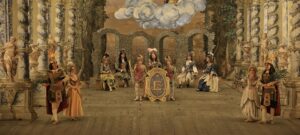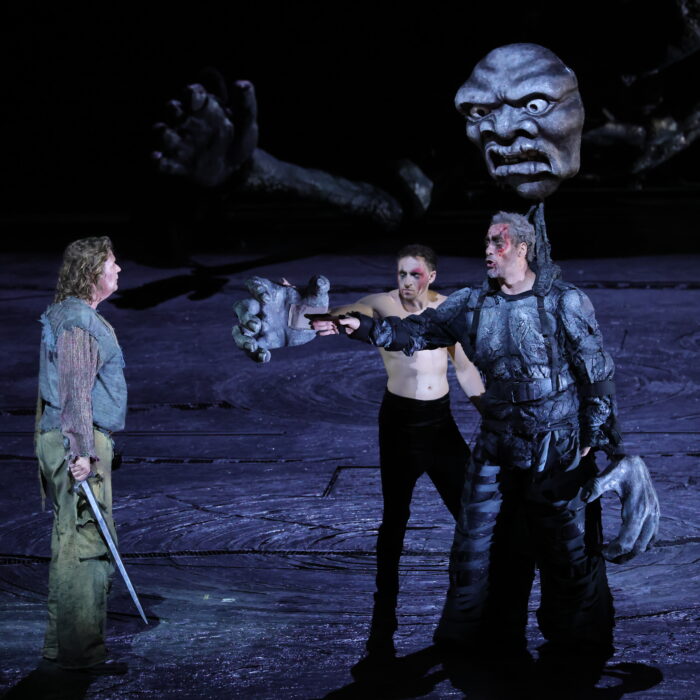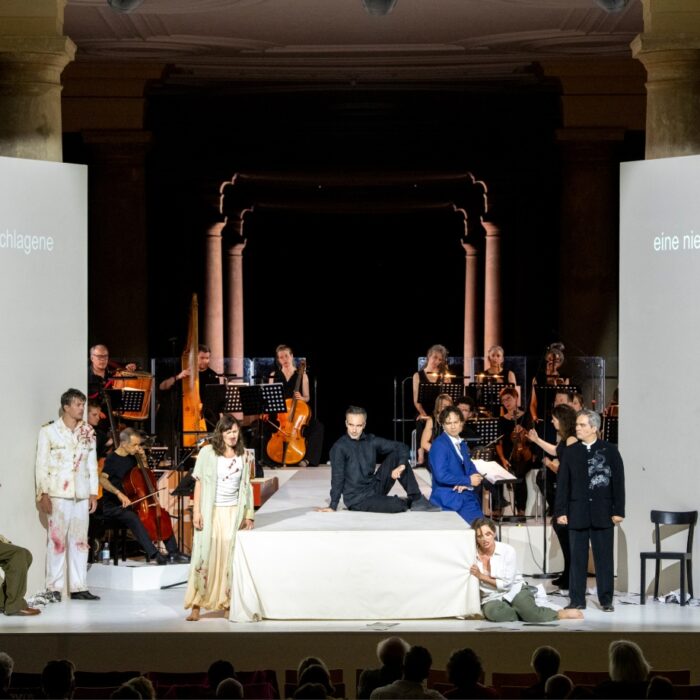
Česky Krumlov 2023 Review: L’Echo Ravvivata
Macek & Vrbová Oversee a Baroque Rarity in Special Venue
By Alan NeilsonOn a bend in the River Vltava in southern Bohemia, perched on a high rocky outcrop, stands the impressive castle of Česky Krumlov. It was founded in the first half of the 13th century by the Lords of Krumlov. Although the dynasty died out, the castle continued to develop under a series of new owners, along with the small town that grew up in its shadow. Today, the town of Česky Krumlov has expanded well beyond its original perimeters. But the castle is still there, and it still dominates the landscape.
With a history stretching back almost 800 years, it comes as no surprise that the castle encompasses a wide range of architectural styles, from the early Gothic, Renaissance and Baroque eras. Built in 1765-66, by the Dukes of Schwarzenburg, it is the town’s Baroque theatre and must-see feature.
The Castle Theater
During the post-war communist era, the theatre suffered serious neglect and seemed destined to become no more than a memory recorded in the castle guidebook. Fortunately, wise heads decided that the theatre should be restored. Today, when you walk into the theatre, it is like walking back in time. The auditorium, decorated in the style of the lighter, late Baroque, consists of a lower area in which the audience is seated on raised benches and an upper tier with a single central box for the duke in its centre. Benches are also arranged around the sides of the balcony. The orchestra is positioned around a central stand in front of the stage with the musicians facing each other, so that half of them face the stage and the other half face the audience. The musical director sits at one end with the continuo and can see the orchestra along a horizontal line. The original stage machinery is still used to change the original scenery, and to lower singers on clouds so that they hang above the stage area.
Such is the theatre’s age and delicacy that great care is taken to preserve its integrity. However, for three evenings each year, an opera is given a fully staged performance, in which every effort is made to recreate a historically authentic presentation. As part of this year’s Baroque Arts Festival, musical director Ondrej Macek opted to stage the first modern performance of Antonio Gianettini’s 1681 pastoral opera, “L’Echo Ravvivata.” This was originally written to celebrate the birthday of Eleonore Maria Josefa Habsburg, Archduchess of Austria, Princess of Bohemia and Hungary, Queen of Poland and Duchess of Lorraine.
The work consists of a prologue and three acts. It is about the tale of Echo who, having been rejected by Narcissus, has decided to forsake love. She is, however, pursued by two suitors, Lico and Timante. But, her heart remains hardened to their pleas. Fortunately, they attract the attention of Pasithea and Laia, and Echo is happy to play matchmaker. The opera ends with Amore congratulating Eleonore on her happy day.
Although only a short opera, it does contain around 30 mostly brief arias separated by recitatives and a number of dances, to music composed by Giovanni Battista Vitali.
The role of the director for a historically informed performance, especially in Česky Krumlov’s historic castle theatre which still possesses its original design and scenery, will have a different emphasis than for a normal performance. The director will not be seeking to impose a reading, but rather trying to uncover how the opera would have been presented during the period in which it was written. Thus, the focus will be on movement and gestures. Although a complete and perfect representation is, of course, impossible, it is the duty of the director to move towards the ideal. Decisions are made regarding the choice of scenery, with the flats selected from the originals still in storage. But, this does not preclude new scenery which has been constructed to conform to the aesthetics and practices of the period. Likewise, new costumes are created to conform the fashion of the period. The lighting should be a naked flame. But in this case, electric lights in the shape of candles were used, no doubt for safety reasons.
Stage director Zuzana Vrbová, costume designers Markéta Štormová and Irena Krízová, and choreographer Veronika Rehbergerová brought this year’s opera to the stage. And they did a fine job!
Vrbová instructed the singers to pose in reflection of the emotion they were portraying. Although they were not static, their arms, legs and hands were restricted in movement. Singers who were present on stage but not singing remained stationary. Visually the staging was balanced, with the singer standing at the front of the stage, usually in its centre. The scenery stretched to the back of the stage, although the singers moved only about half way back in order to not destroy the sense of perspective.
Veronika Rehbergerová’s imaginatively choreographed dance scenes were elegantly performed by the Epochal dance ensemble. They expertly reflected the music and dramatic context with emphasis, once again, on maintaining balance. The movements of the four dancers, Blanka Ferjentsik Wernerová, Barbora Šimová, Ota Frühauf and Martin Vaigl, were light, precise and graceful.
Štormová and Krízová’s costume designs were wonderfully ornate and colorful. They captured the sense of Baroque excess. More importantly, they not only complemented each other, but fitted splendidly into the overall theatrical context which one associates with the period.
Enthusiastic Cast Highlights
Macek led the musical ensemble, Hof-Musici, comprised of seven musicians on a variety of stringed period instruments. In a lively and elegant performance, they brought out the melodic beauty of Gianettini’s score. The textures were thin, although not without interest. A pleasing balance with the singers was maintained throughout the evening.
In the title role of Echo was soprano Eva Benett. She produced a lively, confident performance and was fully engaged with her character throughout the performance. Her recitatives were intelligently crafted, using dynamic variations and colorful inflections to bring out the meaning of the text. Although occasionally, a degree of harshness did creep into the voice. Her arias were detailed, emotionally expressive, and used to show off her ability to mould the vocal line with well-placed inflections and pleasing embellishments. Her opening section of the prologue, in which she sang two arias separated by a substantial passage of recitatives, was nicely rendered and set the tone for the rest of the performance.
Soprano Kamila Zborìlová produced a beautifully sung performance in the role of Laia. She possesses a flexible voice, which she used sensitively and imaginatively to develop her character. In her Act two aria “Già ch’amante,” she voiced her joy at the prospect of winning over Lico with her gentle coloratura and a series of delicately woven ornamentations. This allowed her to show off her appealing upper register. Unfortunately, there was a tendency for her voice to disappear mid-phrase, which undermined the overall effect.
Tenor Tomáš Kočan as Lico, appeared to be singing somewhat within himself for large parts of the performance. He possesses a voice with an attractive timbre. His singing is clear, articulate and precise. However, he would benefit from taking more risks; too often, his inflections were weak and his embellishments too simple and lacked interest. This ultimately impacted his ability to express emotions with sufficient strength. His aria “Non fia mai ver,” however, did show more ambition and was consequently more successful.
Soprano Lucie Rozsnyó produced an expressively urgent and colorful performance in the role of Pasithea. However, whereas she successfully conveyed her emotional states, her vocal control was, on occasions, wanting. Her vocal embellishments varied in quality and her dynamics were inconsistent. Nevertheless, it was a spirited performance that captured the essence of her character.
Tenor Tomáš Lajtkep made a fine impression with his lyrically attractive singing in the role of Timante. He has a secure voice that rests easily on the ear, which he showed to good effect in the aria “Su generosi.” Supported by Hof-Musici’s vibrant accompaniment, Lajtkey produced a beautiful rendition that captured the aria’s strong and inviting melody.
Playing the small part of Amore, Eliška Minárová entered the stage from above and lowered on a cloud. Although she had only a single passage to sing at the end of the opera, she acquitted herself well, showing off her clear-toned, bright, and versatile soprano.
A Different Experience
The star of the show, however, was the theatre itself. Watching the historically informed performance of “L’Echo Ravvivata” in an 18th century opera house was a rare experience indeed. Not only was it more intimate, but aesthetically, it was also very different. The harmony between the theatre’s decorative architecture and staging enhanced the whole experience from an artistic perspective.
Moreover, owing to the artificiality of Baroque theatrical practices, the audience is not drawn into the onstage world. The theatrical illusion does not exist, at least not in a modern sense. The audience is therefore encouraged to view the performance as a work of art, and to appreciate the singers’ skills in representing emotions. One might also admire the fabulous costumes and be entertained by the stage effects. Certainly, the narrative is there to be enjoyed. But, it is viewed for what it actually is: a theatrical representation that the audience can respond to both emotionally and intellectually.
An opera production at Česky Krumlov’s castle theatre is certain to delight any Baroque enthusiast.



